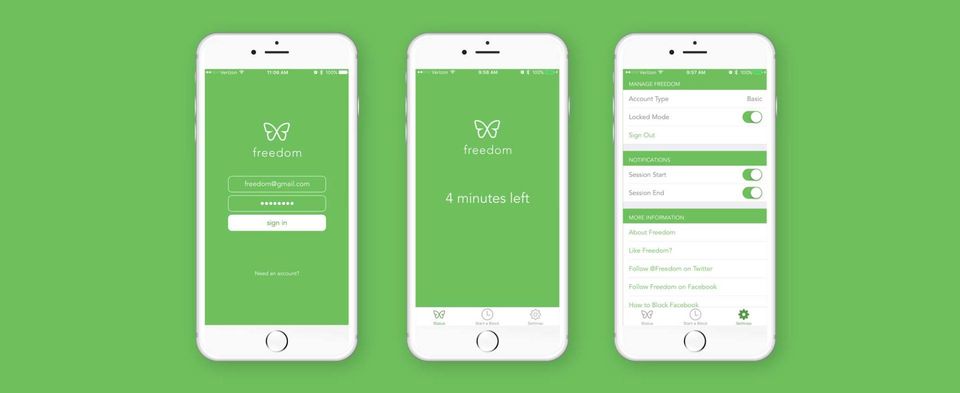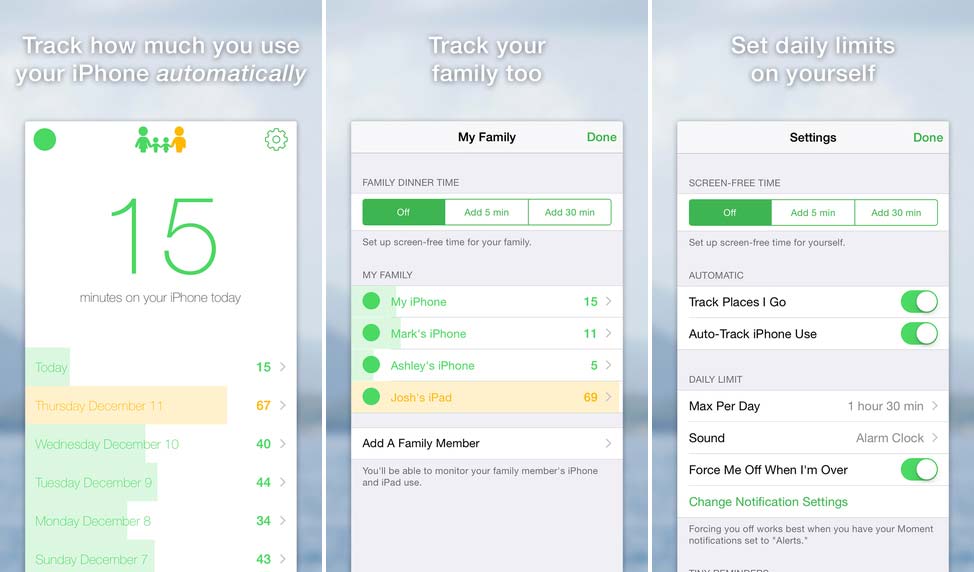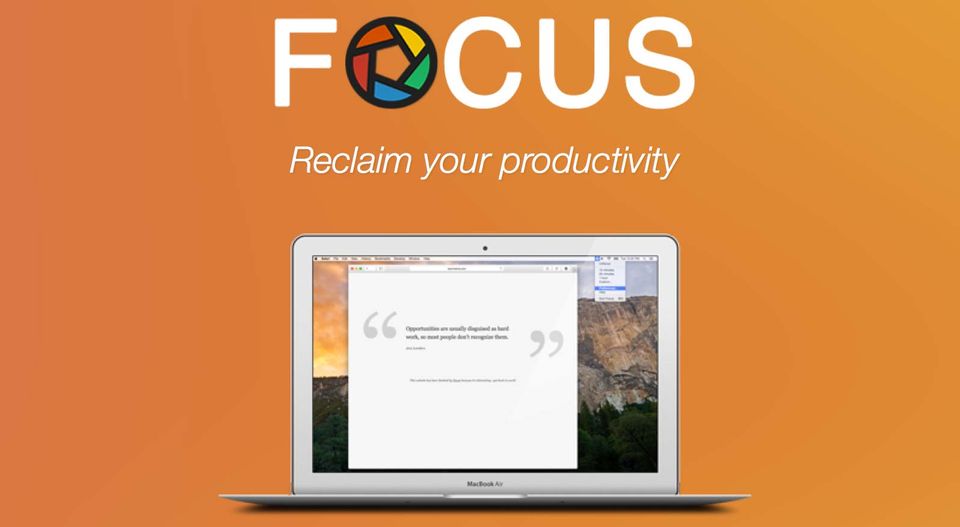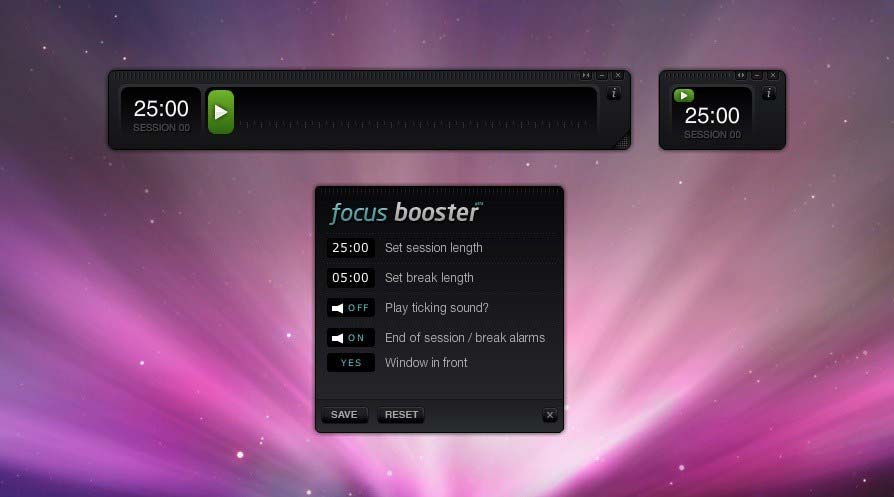9 Apps for Creative Focus
Website Editor • November 17, 2019
Here are some apps that can help you claim back your time, get more productive and possibly become happier after all, a wandering mind is an unhappy mind.
Freedom (iPhone, iPad, Mac)
While it may be an intentional oxymoron, Freedom
completely locks you out of any sites, particularly social media sites, that may distract you from your work across all devices. You can schedule sessions and choose any particular websites you wish to add to the blacklist. With locked mode, there’s also no way to turn it off before your session is up (if you REALLY don’t trust your own willpower). You can even block the entire Internet, if you need complete isolation.

FocusLock (Android)
If you work with social media, completely blocking out these sites might hinder rather than help you. Perhaps your issue is just with distractions on your phone.
This app lets you choose work times and break times, then locks you out of your blacklisted sites. This can also help if you’re addicted to checking out social media first thing in the morning or browsing before bed.
F.lux (desktop) and Twilight (mobile)
Speaking of sleeping, looking at screens before bed has long been proven to negatively affect your sleep cycle, eating into your productivity the next day. F.lux, for your laptop, changes your backlight to a more yellow hue which is easier on the eyes. It gets more dramatically orange over time, also warning you when it’s probably too late to be looking at your screen. If you don’t have an iPhone with iOS 9 or above, which offers this feature, the app Twilight
also offers a similar service for your phone.
Moment (iOS)
How much time do you really spend on your phone? Probably a lot more than you think. Moment
tracks exactly how much time you spend on your phone and lets you set a limit. The app will warn you if you go over the limit and you can choose to be forced off if necessary. There’s also an option to track your family’s usage, so you can try in vain to get your kids to put away their phones at dinner time.
RescueTime (Desktop)
This is a fantastic app for freelancers, RescueTime
comprehensively tracks how you spend your time and sends you a detailed report of your day. You can also set alarms for timed tasks, block unwanted websites, and log highlights from your day.
Focus (Mac)
Another app whose main function is to block out distracting websites is Focus. The beauty of this app is that it displays motivational quotes instead of your blocked page to remind you why you’ve blocked it in the first place.
Focus Booster (desktop)
The pomodoro technique gets a lot of praise in the productivity world. It’s a particularly useful technique for the easily distracted. Work is broken down into small segments, typically 25 minutes or longer, followed by a 2-5 minute break. After 4 sessions, or “pomodoros” you take a longer break. Focus Booster
manages this for you and also reports in detail how you spend your time. If you’re better suited to spurts of productivity, this is for you.
OFFTIME (Android)
If your work can be taken offline entirely, OFFTIME is a great app for blocking out all potential distractions. You set a creativity (or quality time) period during which calls and notifications will be blocked to allow you to focus. Texts will also be auto answered saying when you’ll next be available, and the app will give you a breakdown of what you missed at the end of your OFFTIME.
Now that you’re all set to be a productivity machine and claim back all that time you’ve spent mindlessly scrolling, how will you spend it? With family, on leisure time, or on a new project? It’s your choice, enjoy it.
Scriba is a revolutionary digital stylus that is ergonomically designed to comfortably fit your hand and uses unique Squeeze-Motion technology. Order here.
Articles

The United Nations has described the disruption to education caused by the pandemic as ‘unparalleled’. At the virus’ worldwide peak in April, it is estimated that over 90% of all enrolled learners, from kindergarten to bachelors and beyond, had their education affected by school closures and the pandemic (UNESCO). For many university students and older children, they have had to adapt quickly to online learning. They can keep in touch with their peers and teachers online and continue their studies, albeit in a highly modified way. As challenging as this may be, this experience will help equip them for a future that is increasingly online. For parents of younger children, they are assuming a new role: their child’s home school teacher. This is in addition to their usual childcare and household duties, their work responsibilities and often emotional and financial worries caused by the pandemic. Stressful? Yes. The good, and somewhat surprising, news? The experts advise that you don’t teach your children - at least not in the way you might expect.

If the recent outbreak of Covid-19 has taught us anything, it's that many adults do not wash their hands effectively. It has never been more important that we support our children to develop good personal hygiene to keep themselves and our families safe. This seemingly easy task can be very difficult for children with fine motor skill difficulties. In this article, we explore some ideas to support your child with hand washing.

Lockdown has brought the digital future into the now. Online shopping, entertainment, education and more have moved from the periphery to the mainstream to, in many cases, the only option. With the necessity of social distancing looking to continue for many months, it appears that this rapid digital revolution is here to stay. This means that life as we know it, in most of its sectors, has changed forever. In order to survive, businesses are having to adapt rapidly, embrace technology and look to the future. Architecture is no exception. There has been a widespread adoption of technology and VR over the past few months in response to the lockdown across all of society. Elderly grandparents who were once resistant to adopt new technologies talk of “Zooming” and have started video chatting with their family members to combat loneliness. Art galleries that were once considered stuffy or pretentious are now pioneers in VR technology, with Google Art & Culture offering tours of London’s National Gallery or the Musee D’Orsay in Paris. These virtual tours deliver art in a dynamic new way that can be far more engaging than regular photos. Critics have applauded the panoramic and immersive views of gallery building and exhibitions which work well for rendering of 2 dimensional art, however impressions of sculpture is somewhat lacklustre. With VR technology, users can enjoy a truly immersive experience in the comforts, and safety, of their own home. The COVID-19 pandemic has served as an accelerant for the arts and entertainment industries to embrace VR.






